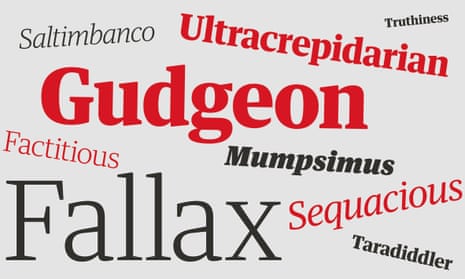As the UK slouches towards yet another general election, the social media giants have adopted contrasting approaches to the problem of dishonest campaigning. Twitter has banned political ads altogether, while Facebook will serenely allow them to spread falsehoods. Indeed, it is often supposed that the age of Trump and Brexit heralds something new: the political supremacy of the lie absolute, the cynical fabrication, the bot-netted virality of fake news. But old words buried in the geological strata of the English language tell quite the opposite story, that made-up facts and boastful dissimulators have always been with us. To unearth and polish these fossils may act as some small consolation, while providing resources for expressive resistance to the ongoing omnishambles.
Last month, the European commission cautiously welcomed some self-assessment reports from Facebook, Twitter, Google, Microsoft and Mozilla under the aegis of its Code of Practice on Disinformation, while noting sorrowfully that “large-scale automated propaganda and disinformation persist”. The word “disinformation”– probably derived from the Russian dezinformacija – stems from the earliest years of the cold war, and properly means sowing falsehoods among one’s enemies in order to confuse them about one’s own capabilities or intentions. But the more general term “misinformation” – spreading untruths – has been around since the late 16th century. Samuel Johnson, writing of the king of Prussia in 1756, said his subject “declares himself with great ardour against the use of torture, and by some misinformation charges the English that they still retain it”.
The age of post-truth, indeed, stretches as far back as you care to look, there never having been a golden age of transparency. The ubiquity of fake news and scientific misinformation was already a serious problem for leading thinkers of the Renaissance. In his Novum Organum (1620), the natural philosopher Francis Bacon describes for the first time the psychological phenomenon that underlies so much of our modern worries about trust and truth – what would only much later be christened “confirmation bias”. Our minds, he notes, tend to lend more weight to “affirmative” (or positive) than to negative results, so a person is likely to “seize eagerly on any fact, however slender, that supports his theory; but will question, or conveniently ignore, the far stronger facts that overthrow it”. In the book, Bacon considers the factors that lead people’s thinking astray, which include wrong-headed notions accepted from bad philosophy and science, various “systems now in vogue” – and inaccurate language: “The ill and unfit choice of words wonderfully obstructs the understanding.”
Such obstruction of the understanding is often, of course, deliberate. A political leader might spread misinformation about foreigners in order to make himself look better by comparison. Other occupants of high office might become so habituated to telling falsehoods in matters both grave and trivial that they deserve the splendid old title of “taradiddler”. The noun “taradiddle”, for the lie itself, is attested from 1796, in Grose’s Classical Dictionary of the Vulgar Tongue, where it is defined as “a fib, or falsity” – perhaps from “diddle” meaning to cheat, with the exclamation “tara!” bolted on to the front. In 1885 the English biologist Thomas Henry Huxley, known as “Darwin’s bulldog” for his championing of natural selection, wrote to a friend: “Everybody told us it would be very cold, and, as usual, everybody told taradiddles.”
Politicians may be apt to spread misinformation, too, if they like to discourse on subjects about which they have no expertise. This, of course, is a long-identified human flaw, for which the most satisfying word is “ultracrepidarian”: someone who opines beyond his expertise. It first appears in a letter by William Hazlitt, though an earlier version, “ultra-crepitast”, is recorded in 1640. The term might usefully be applied today to presidents who claim to “know more about drones than anybody”, as well as to all manner of media celebrities and low hacks.

A plausible manner and confidence in speech may lend weight to claims that are fake news – or, let us more nobly say, “factitious”. What is factitious is, oddly, not a fact. Both words derive ultimately from the Latin facere, to make or do, but while a fact (Latin factum) is something done, a factitious thing (Latin factīcius) is something “of the made sort”, something manufactured or artificial – and so, in English, often deceptive, false or inauthentic. Perhaps, just as Stephen Colbert’s coinage “truthiness” means the quality of seeming but not really being true, we might employ “factitiousness” for the quality of seeming to have, but not really having, something to do with the facts.
Like Bacon’s Novum Organum, the word “factitious” (first recorded 1624) comes from a much earlier age of worries about the reliability of information. In 1646, the physician and philosopher Thomas Browne published his Pseudodoxia Epidemica, a title you might translate topically as “An Epidemic of Fake News”, concerning the “vulgar errors” and superstitions of the age. Among the rogue’s gallery of mischievous agents of misinformation portrayed are “Saltimbancoes, Quacksalvers, and Charlatans”. This is the first recorded use in English of the word “saltimbanco”, to mean “an itinerant charlatan who sold supposed medicines and remedies” (OED). The word derives from the Spanish saltinbanco, which in turn comes from the Italian phrase saltare in banco: to jump on to a bench, as the travelling quack would do in the street to attract an audience. (Happily, mountebank means exactly the same thing, formed from the Italian monta in banco.)
Saltimbancoes would not be so much of a problem if people were able to resist their false promises, but the fact that this is difficult was also a phenomenon discussed earnestly 400 years ago. A “gudgeon” is a little fish (Gobio fluviatilis), which is “of pleasant taste”, so someone records in 1620, and which anglers often use for bait to catch larger fishes. It is not the cleverest of fish; indeed, remarks a 17th-century gentlemens’ manual, gudgeons “are Fish of eager bite and soonest deceived”. Which is why a “gudgeon”, from the early modern era, could also be a credulous, gullible person. In Reginald Scott’s important sceptical history of supposed black magic, The Discoverie of Witchcraft (1584), the author describes the practice of inserting needles into a wax figurine of someone you wish to harm, and judges: “They would do no harm, were it not to make fools, and catch gudgins.” The same can be said of cults and quackeries to this day. Though the existence of the internet in principle ought to make it easier to refute disinformation, that is in practice hard to do when putting one’s mouth to the firehose of digital lies every time one looks at a smartphone. Indeed the internet is really the biggest imaginable bench for today’s saltimbancoes to leap on to, in order to fish for their gudgeons.
The online world, too, is a fertile breeding ground for zombie ideas: long-refuted notions – such as the Flat Earth conspiracy or the idea that the MMR vaccine causes autism – that are the living dead of intellectual exchange. But this is not a new phenomenon either, as witnessed by the history of the word “mumpsimus”, in the sense of “a person who obstinately adheres to old ways in spite of clear evidence that they are wrong” (OED). The Renaissance scholar Erasmus tells the story of its origin like so: once upon a time, an illiterate English priest was scolded for having read “quod ore mumpsimus” in the Latin Mass when he should have said “quod ore sumpsimus” (literally, “what we have received by mouth”). The priest replied heroically: “I will not change my old mumpsimus for your new sumpsimus.” And nor will all too many people today.
But it has long been recognised that it is not necessarily their fault, as evidenced by the useful old word “fallax”, from 1530. Now, dictionaries will tell you that “fallax” is just an obsolete form of the word “fallacy”, but the special sense of the former is of something either especially likely to mislead, or deliberately created to do so. In his 1656 dictionary, Glossographia, Thomas Blount defines a fallax as “a thing that’s apt to deceive”, and it is this sense of a powerful trap lurking in wait for the unwary that seems worth preserving, as long as the deliberate elevation of fallax by those in power continues.
It might be no shame to fall victim to fallax, but some people in thrall to one mumpsimus or another could well be the “sequacious” type in general: from 1653, an adjective for an unquestioning acolyte, a slavish adherent of some person or school of thought. It is derived from the Latin sequāx, a follower, and can also be used of biddable beasts, or tractable objects, though its psychological meaning seems still the most relevant. The poet and playwright James Thomson defined a philosopher as one opposed to the sequacious multitude in his “Summer: A Poem” (1730): “The vulgar stare; amazement is their joy, / And mystic faith, a fond sequacious herd! / But scrutinous Philosophy looks deep, / With piercing eye, into the latent cause; / Nor can she swallow what she does not see.”
As we brace for yet more Trump and Brexit in 2020, the identification of any modern collection of persons that might be thought to comprise a “sequacious herd” is here left as an exercise for the reader.
